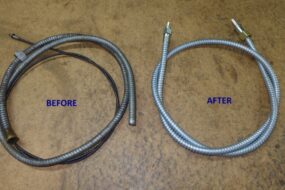Stabilizeroutputterminal
In modern cars many of the instruments are fed power through a voltage stabilizer. If this is faulty all the instrument readings will become erratic. Before testing individual instruments check the stabilizer is not at fault by connecting the meter between its output terminal and earth.
The meter should read around 10 volts although it might pulsate slightly because of the regulator. Any lower or higher means the stabilizer needs
replacing.
Earthpoint
Senderterminal
Disconnect the wire from the sender terminal then connect the test meter between the vacant terminal and an earth point. You should get a range of readings, depending upon the position of the sender unit float. If no reading is shown, the sender unit needs to be removed for replacement or repair.
The petrol tank sender unit uses a variable resistor, which you can check
for continuity by using the resistance scale on the multi-meter.
Disconnect the wire to the sender unit and connect the meter between its terminal and a suitable earth point. If the sender unit circuit is complete, there should be a definite reading on the meter. To make a complete check make
individual readings with the tank full, half full and empty.
The three readings should fall in progression with more or less equal gaps between them. If two of the readings are very close together it is likely that some of the resistor tracks have shorted out, giving false readings on the
gauge.
Ignition tests
When checking the low-tension circuit remember the contact breaker points
have to be closed to complete the circuit.
If the coil uses a ballast resistor the voltage at the input terminal will be lower (usually around 6 to 8 volts) due to the action of the resistor. To check the coil starting voltage, connect a lead between the coil points terminal and earth. Operate the starter briefly to bypass the ballast resistor.
The value should be around 12 volts. Remove the lead.
If the value did not rise to this level there is a fault in the low-tension
circuit or the solenoid terminal connections.
You can check the points by measuring any voltage drop across them. Connect
the meter between the points terminals on the coil and earth.
With the contacts closed, turn the meter to read on the low volt scale. The reading should ideally be in the zero to 0.5 volts range. Any more than 0.5
volts indicates the points are faulty.
Turn the meter to the high volt scale and open the points. The voltage
should be the same as that on the input side of the coil.
A zero reading may be because of a fault with the distributor and you can check this by disconnecting the distributor lead. If the reading is still zero there is a fault in the coil, but if it rises there is a fault with the
distributor.
High-tension leads
You can use the resistance setting of the meter to check for problems with high-tension leads. If the car has an intermittent misfire, you may be able to
trace it to one of the leads.
Find out which type of lead is fitted. Carbon leads have a resistance in the 10,000-25,000 ohm range. Copper-cored leads have a very low resistance but may be fitted with resistive plug caps for radio suppression and these have a
resistance of around 10,000 ohms.
Disconnect each lead from the spark plug and distributor cap and hold the meter lead probes to the central core at each end. Make sure the meter reads
correctly.
To check the HT lead insulation hold one probe to the central core of the lead and the other to the insulating plastic. If the lead is in good condition
there should be no movement on the meter scale.
Charging system checks
Run the engine until it has reached normal working temperature and then
switch it off.
Set the multi-meter to the correct voltage scale (0 to 20 volts) and connect it across the battery terminals. Start the engine and note the voltage reading, then slowly increase the engine speed up to about 2000rpm,
at the same time checking the voltage readings on the meter.
If the system is working correctly the voltage should increase with the engine speed and then stabilize, so that if the engine is revved further
the voltage reading will remain the same.
In general the upper volt reading is in the region of between 13.5 to 14.5 volts although it varies from car to car. If the voltage reading fails
to increase there is a fault with the charging circuit.
Battery meter
There is a special type of multi-meter for checking the performance of the battery under heavy load, such as starting. It consists of two large prongs connected together with a heavy duty resistor and a voltmeter
between them.
Touch the prongs to the battery terminals for a few seconds while the voltage reading is taken. If the battery is in good condition the voltage
should not fall below 9 volts.
You can use a multi-meter to make the same check. Disable the ignition system by disconnecting one of the coil LT leads. Connect the meter across the battery terminals and get a helper to operate the starter for a few seconds while you watch the voltage reading. Again, it should not fall
below 9 volts.
Current readings
Measuring the current output from a dynamo or alternator is more difficult with a multi-meter because the current levels produced by the generator are too
great to be directly handled by most meters.
To use the meter to check the current output you have to fit what is known as a shunt to the circuit. This is a length of wire with a specific resistance. The meter is connected across the shunt wire and senses a voltage drop across it which gives a measure of the current flow. The shunt may be available with
the meter. If not, you can find out from your manual the type you need.







